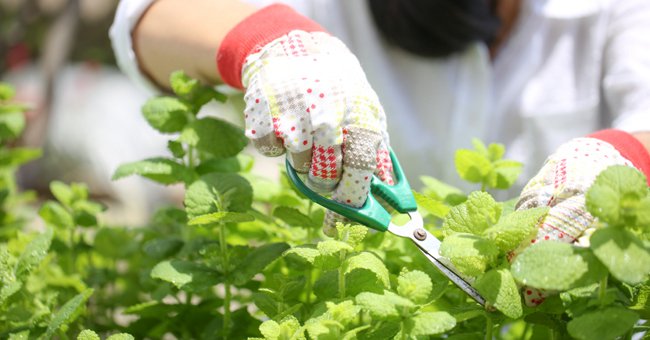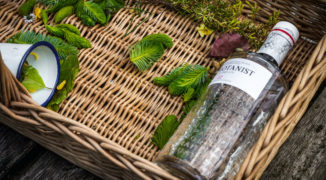Long gone are the days when candy-red cocktail cherries and lime wedges represented the extent of a bar’s botanical garnishes. With more and more bartenders prioritizing fresh juices and house-made syrups, some bars might look more like the lab of a 19th century botanist, rife with herbs, flowers and other plant life employed in libations that are full of vitality. And it’s awesome. What better way to coax flavors from spirits than to marry them with beautiful bright things that sprout from the ground?
Truly any bar (yes, even a home bar) can benefit from growing its own ingredients, and if your space is limited, it can be as simple as a few herbs in the windowsill or a couple small pots out back. Here are some basics to get you started.
Mint, basil and friends
There are so many choices in the unofficial family of herbs that include mint and basil; and whether they fall into the minty, citrusy, floral or herbaceous camp, they can define a cocktail with beautifully subtle intensity. The granddaddy of these drinks would have to be the mint julep, with the mojito hot on its tail. But whether you go with an all-out herbal recipe, or just experiment, there’s just nothing like the aroma and flavor of these verdant leaves in a cocktail. You can also freeze some leaves in ice cubes or use stems to garnish.
Best for: Outdoors (or indoors with plenty of sunshine)
Tips for growing: Snip basil buds to prevent going to seed, and prune regularly for a plant that yields more leaves. (And make sure mint gets its own pot or plenty of space—that stuff grows like a weed.)
Rosemary, thyme and company
These woodsy herbs are a little less floral and a bit more assertive. They are perfect for infusing liquors, using as a garnish, or employing a sprig as a swizzle stick. Infusions are super simple: you can just wash a few stems of rosemary, put them in a bottle of vodka, and allow them to sit for at least 24 hours. Even at their simplest – say, rosemary vodka with ruby red grapefruit juice for a balsam-tinged greyhound – herb-infused spirits bring a lot to the table.
Best for: Anyone, even if you rarely manage to keep plants alive. Rosemary in particular is hardy and, with decent sunlight and semi-regular watering, can withstand even the blackest of thumbs.
Tips for growing: If growing in pots, make sure your thyme and rosemary both have good drainage, and don’t overwater them.
Chili peppers
There is a crazy array of peppers out there, and many of them are picture perfect for cocktails. Some, like jalapeños, are great for infusing liquors; others are good when dried and crushed with salt for a spicy rim that plays the perfect foil to a sweet and tart margarita.
Best for: Warmer climates. In areas with cool, damp weather, you might need to nurture your chilis in a greenhouse (even if it’s just a small, portable one).
Tips for growing: The smaller the fruit, the more peppers your plant will yield.
Ginger
Growing ginger is fun, and it is a great secret weapon in the bar. Use it for infusions, or make a ginger simple syrup that will add a sweet and spicy kick to whatever it graces. Even just a bourbon and soda with a splash of ginger syrup is a revelation.
Best for: Warm, humid climates, but ginger also does well in containers, so cooler areas can try growing it indoors.
Tips for growing: Pick up a ginger root from your local market, soak it in water overnight, and plant it in high-quality, rich soil. You’ll have immature (but edible) green ginger in several months.
Cucumbers
Cucumber brings a fresh melon-y snap to drinks, and it’s a workhorse behind the bar:. It can be used to infuse liquors, it can be muddled with herbs (from mint to basil to rosemary), mixed with jalapeño, or even just used as a garnish. Think: spicy cucumber margarita; gin with cucumber, elderflower and lime; vodka with cucumber, lemonade and rosemary… the possibilities are endless. Cucumbers are also the second-most popular homegrown vegetable in the U.S., which makes sense: all you really need for cukes is decent sunshine.
Best for: Areas that get full sunlight. You can start them early in pots indoors (early spring) if you want to get a head-start on the growing season.
Tips for growing: Choose a bush variety (rather than a vine) to maximize space: they’re ideal for small plots or containers, and you don’t have to deal with trellises.
Citrus
Depending on where you live, citrus-growing may not be all that practical – not all of us can have an “orangerie” a la Marie Antoinette in which to grow citrus during intemperate months. No matter where you live, house-grown citrus can work wonders behind the bar, and experimenting with less standard varieties like Meyer lemon and satsumas can yield exciting results.
Best for: Warm, sunny climes—but there are workarounds.
Tips for growing: If the temperature in your area dips below 25 Fahrenheit, don’t give up just yet. Dwarf varieties can be grown in a container and moved to a sunny spot indoors when the mercury drops. Try naturally small varieties like Improved Meyer lemon, Bearss lime, Satsuma mandarin or kumquat. Your cocktails will thank you.
Tomatoes
Whether you’re blending up fresh Bloody Mary mix or capturing a savory side of summer with infusions, heirloom tomatoes are great to have on-hand in the bar—and, while not as dead-simple as rosemary, still fairly easy to maintain. Plus, a shot of tomato-spiked vodka mixed with a shot of fresh orange juice and a dash of Tabasco, chilled, is heaven in and of itself.
Best for: Slightly advanced growers in sunny areas. A gardening newbie certainly can grow tomatoes, but they require a little more maintenance than your average rosemary bush.
Tips for growing: Use compost in your soil. And support is key: experiment with trellises, cages and stakes so vines don’t snap under the weight of those beautiful healthy fruits.
Edible flowers
Consider these the icing on the cake. Edible flowers add more of a visual flourish than flavor, but that said, blooms from herbs will give your creations some nice punctuation. There are 42 flowers deemed edible, and any of them can be used somehow, somewhere, in your mixing of drinks. Petals or small whole flowers can be frozen into ice cubes, sprigs with blooms can be used as swizzle sticks, fragrant flowers like roses and lavender can be used for infusions, and edible flower simple syrup (dandelions are great this way) can give some sweet floral grace to anything you can put in a glass.
Best for: anyone, really—there’s an edible flower for just about any kind of grower. Check out nasturtium for its low-maintenance ease.
Lavender
Lavender has a fragrance and complexity that is utterly unique, and marries perfectly with a wide range of liquors. You can use to it make an infusion or use as a flavorful garnish, but there are also legions of cocktail recipes that rely on it. Dried lavender mixed with sugar makes an incredible sugar rim. Bonus: they’re also a cinch to grow in containers.
Best for: Anywhere with good drainage and circulation—lavender does exceptionally well in containers.
Tips for growing: Lavender plants favor infrequent, deep watering over daily sprinklings. And give them a larger pot than you think you’ll need: they can grow from a few sprigs to a large shrub in less time than you’d expect.





